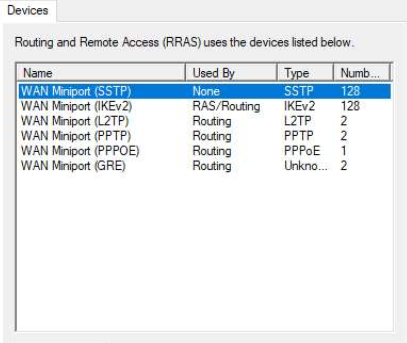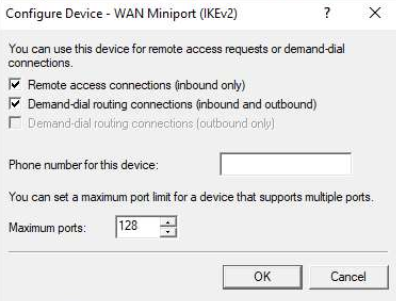Always on VPN - Error 809 The network connection between your computer and the VPN server could not be established
I ran into a weird issue, troubleshooting an 'Always On VPN' installation running off Windows Server 2019, the clients were getting the following error in the Application event log:
Error 809 The network connection between your computer and the VPN server could not be established
In my case, the issue wasn't due to IKEv2 Fragmentation or anything to do with NAT to allow the origin IP to flow to the Always-on VPN server. It was due to the ports being limited to: '2'. I found an old post regarding Windows Server 2008 R2:
"If more than two clients try to connect to the server at the same time, the Routing and Remote Access service rejects the IKEv2 connection requests. Additionally, the following message is logged in the Rastapi.log file:"
This matched my issue; I had never seen more than 2 connections at once.
Increase Ports
- Open Routing and Remote Access
- Click on your Routing and Remote Access server
- Right-click on Ports
- Click on: WAN Miniport (IKEv2)
- Click Configure
- Ensure that: To enable remote access, select Remote access connections (inbound only) is checked.
- Change Maximum ports from 2 (as an example) to a number that matches how many connections you want - I went with 128
- Click Ok
- Click Apply
- Restart the Routing and Remote Access server. You should now see more ports listed 'as inactive' until a new session comes along and uses it.


Enable TLS 1.1
Although this wasn't my initial fix, I had a Microsoft Support call opened regarding this issue; after analysing the logs, they recommended enabling TLS 1.1 (which was disabled by default on a Windows Server 2019 server). I would only do this as a last resort - if required.
Run the PowerShell script below (as Administrator) to Enable; you can always rerun the Disable script to remove the changes.
Enable TLS 1.1
function enable-tls-1.1
{
New-Item 'HKLM:\SYSTEM\CurrentControlSet\Control\SecurityProviders\SCHANNEL\Protocols\TLS 1.1\Server' -Force
New-Item 'HKLM:\SYSTEM\CurrentControlSet\Control\SecurityProviders\SCHANNEL\Protocols\TLS 1.1\Client' -Force
New-ItemProperty -Path 'HKLM:\SYSTEM\CurrentControlSet\Control\SecurityProviders\SCHANNEL\Protocols\TLS 1.1\Server' -name 'Enabled' -value '1' –PropertyType 'DWORD'
New-ItemProperty -Path 'HKLM:\SYSTEM\CurrentControlSet\Control\SecurityProviders\SCHANNEL\Protocols\TLS 1.1\Server' -name 'DisabledByDefault' -value '0' –PropertyType 'DWORD'
New-ItemProperty -Path 'HKLM:\SYSTEM\CurrentControlSet\Control\SecurityProviders\SCHANNEL\Protocols\TLS 1.1\Client' -name 'Enabled' -value '1' –PropertyType 'DWORD'
New-ItemProperty -Path 'HKLM:\SYSTEM\CurrentControlSet\Control\SecurityProviders\SCHANNEL\Protocols\TLS 1.1\Client' -name 'DisabledByDefault' -value '0' –PropertyType 'DWORD'
Write-Host 'Enabling TLSv1.1'
}
enable-tls-1.1
Disable TLS 1.1
function disable-tls-1.1
{
New-Item 'HKLM:\SYSTEM\CurrentControlSet\Control\SecurityProviders\SCHANNEL\Protocols\TLS 1.1\Server' -Force
New-Item 'HKLM:\SYSTEM\CurrentControlSet\Control\SecurityProviders\SCHANNEL\Protocols\TLS 1.1\Client' -Force
New-ItemProperty -Path 'HKLM:\SYSTEM\CurrentControlSet\Control\SecurityProviders\SCHANNEL\Protocols\TLS 1.1\Server' -name 'Enabled' -value '0' –PropertyType 'DWORD'
New-ItemProperty -Path 'HKLM:\SYSTEM\CurrentControlSet\Control\SecurityProviders\SCHANNEL\Protocols\TLS 1.1\Server' -name 'DisabledByDefault' -value '1' –PropertyType 'DWORD'
New-ItemProperty -Path 'HKLM:\SYSTEM\CurrentControlSet\Control\SecurityProviders\SCHANNEL\Protocols\TLS 1.1\Client' -name 'Enabled' -value '0' –PropertyType 'DWORD'
New-ItemProperty -Path 'HKLM:\SYSTEM\CurrentControlSet\Control\SecurityProviders\SCHANNEL\Protocols\TLS 1.1\Client' -name 'DisabledByDefault' -value '1' –PropertyType 'DWORD'
Write-Host 'Disabling TLSv1.1'
}
disable-tls-1.1
